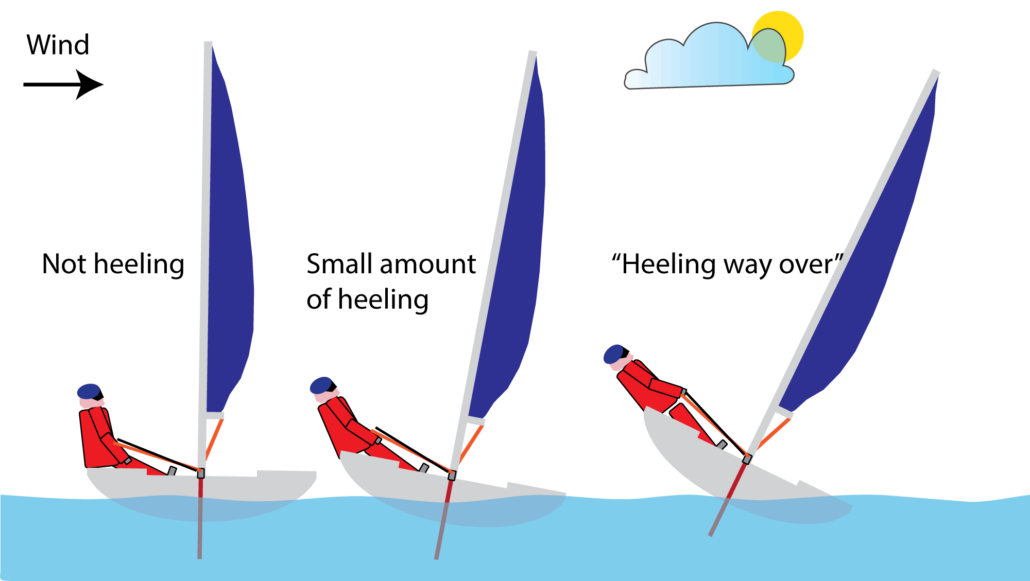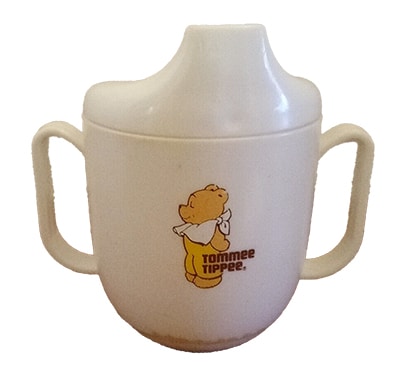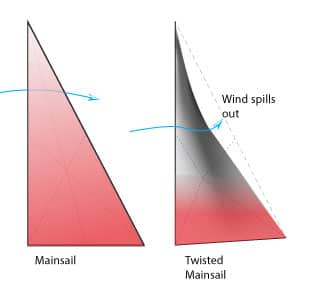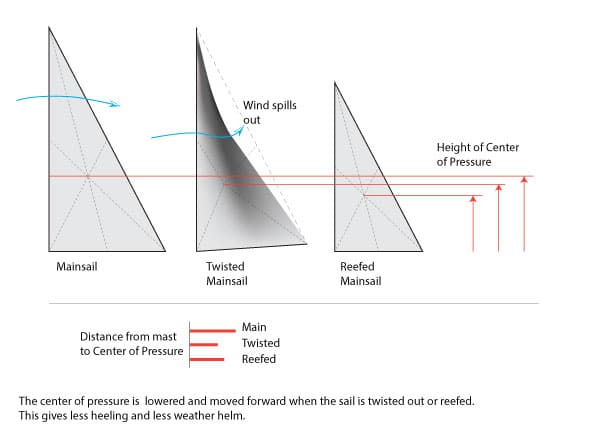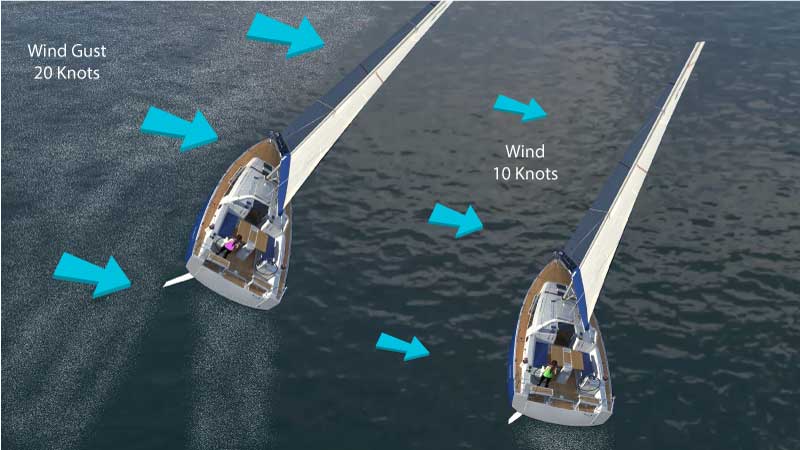Sign up with NauticEd for FREE (no obligation) and receive 2 free boating courses, a free eLogbook and boating resume, and more! If you want to get started in boating or are experienced and want to expand your knowledge and skills, consider taking our many online sailing and powerboating courses.
What is Angle of Heel on a Sailboat
And, what Angle of Heel on a Sailboat is acceptable?
What is heeling over on a sailboat?
Heeling over or “heeling” on a sailboat is when it leans over.
Why does a sailboat heel over and why doesn’t it tip over?
Remember your tommee tippee cup? It had a rounded bottom and a weight loaded into the rounded bottom. No matter how much water you put in the cup, the weight at the bottom made sure the cup stood upright – and the rounded bottom meant that if you pushed it over, it would stand right back up.
Your finger pushing sideways on the top of the cup is just like the wind acting on the sails. The wind acting on the sails puts pressure on the sails. Pressure over the entire area of the sails creates a force. The greater the area, the greater the force, and the stronger the wind, the stronger the force. The distance the force is collectively acting on the sails is about 1/3 of the way up the sails. This point is called the center-of-pressure. This is like your finger pushing all the wind’s force at that center-of-pressure point. The sailboat, like the tommee tippee cup has no choice but to lean (heel) over.
The propensity for the sailboat to heel over depends on the height (distance) of the center of pressure above the water line. The physics formula for this is force x distance which equals a physics term called “moment” (not like a moment in time). The “moment” can be considered as the same as “torque” or even easier – as the “tipping force” or (heeling force). The greater the distance and force – the bigger the tipping force.
In high wind conditions, you can lower the center of pressure by spilling some of the wind out of the top of the sails by twisting out the sail at the top (done by easing the mainsheet which allows the boom aft to rise – thus creating less tension on the leech of the sail and allowing the top to twist out).
Twisting out the top of the sail has a double effect. There is less sail area presented to the wind at the top. This means a lower center-of-pressure (less height) and less area – giving rise to less tipping moment.
Another way to lower the center of pressure is to reef the sail (partially lower it). This also acts to reduce the area of the sail. Less area and less height of the center-of-pressure reduces the tipping force. Here is an image showing reefing and twisting effect on the tipping moment. The image also discusses how twisting and reefing moves the center-of-pressure forward. This has the added benefit of reducing what is known as weather helm – the boat wants to automatically turn up into the wind.
What stops the sailboat from completely tipping over?
A balance between gravity acting on the weighted keel and the wind force on the sail stops the boat from completely tipping or heeling over. As the boat heels over, the sail area is not upright and so less sail area is presented to the wind. Also as the boat heels over, gravity acting on the weighted keel that is rolling upwards with the heel of the boat creates a force to stand the boat back upright. At some point, both forces meet in agreement and compromise with a defined heeling angle.
Imagine the weighted keel is just like how your Tommee Tippee cup uses gravity to force the boat to stand back upright. Thus it becomes a balance between the boat being pushed over by the force on the sails and the weight of the keel trying to stand it back up.
See this animation below of the balance of forces. CLICK on the green Increase Wind button. You will see how the “righting force” increases as the weighted keel lifts outwards off the centerline. You’ll also see how the tipping force decreases because less sail area is presented face-on to the wind. It means that the righting force from the keel will always overpower the wind force at some angle of heel. This is not to say that sailboats never tip over, they do but only usually in cases of a massive unprepared-for gust (60+ knots), giant wave, or if they lose their keel. Dinghies of course do tip over from the improper balance of the crew.
What is an acceptable heel angle?
The acceptable angle of heel on a sailboat depends on various factors, including the design of the boat, its ballast, the boat’s purpose, and the prevailing conditions. Generally, here are some guidelines:
- Dinghies and Small Boats: Dinghies are designed to be agile and may heel significantly, especially when sailed aggressively. Capsizes can happen but are often a part of dinghy sailing.
- Cruising Sailboats: Most cruising sailboats are designed to be stable and comfortable. They typically perform best at an angle of heel between 10° and 20°. Once a cruising boat heels beyond 20°, its weather helm tends to increase, making it more challenging to steer, and the boat might not sail as efficiently.
- Racing Sailboats: Racers might push their boats harder, and some racing designs can handle more heel. Nevertheless, excessive heel can still decrease speed as more wetted surface (hull in the water) causes increased drag.
- Multihulls (Catamarans and Trimarans): These vessels are designed to sail relatively flat. Heeling angles over 10° can be a cause for concern on a multihull. When a multihull starts to heel significantly, there’s a risk of capsize, especially if a hull lifts entirely out of the water.
- Keel Design: Boats with full keels tend to be more stable and resist heeling more than those with fin keels or lifting keels. However, once they reach a certain heeling point, full keel boats can be more challenging to bring back upright.
- Seaworthiness: Some boats, especially bluewater cruisers, are designed to be very seaworthy and can handle significant heel angles, even beyond 45°, without capsizing. Still, this doesn’t mean it’s comfortable or efficient to sail them at such angles.
Factors like gusty winds, big waves, and the condition of your sails (e.g., having a full mainsail up in strong winds) can also influence heel.
What to do if you are getting excessive heeling angle:
- Reef Early: Reducing sail area can help to decrease heeling and make the boat easier to control.
- Adjust Sail Trim: Flatten your sails by tightening the outhaul, cunningham, and backstay (if adjustable).
- Change Your Point of Sail: Sailing more downwind can reduce heeling, but be cautious about accidental jibes.
- Ease the Sheets: Letting out the mainsheet or headsail sheet can reduce power in the sails.
Lastly, the best way to understand how much heel is acceptable for your specific boat is to gain experience in various conditions and, if possible, consult with more seasoned sailors or trainers familiar with your type of boat.
This information was drawn from the NauticEd Skipper Course (for large keelboats) and the NauticEd Skipper Small Keelboat Course. Sign up now to learn the knowledge you need to know to effectively skipper a sailboat.
You can learn more with NauticEd

Sign up with NauticEd for FREE (no obligation) and receive 2 free boating courses, a free eLogbook and boating resume, and more! If you want to get started in boating or are experienced and want to expand your knowledge and skills, consider taking our many online sailing and powerboating courses.

